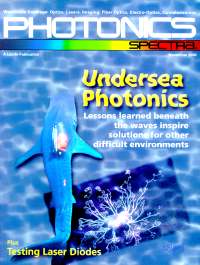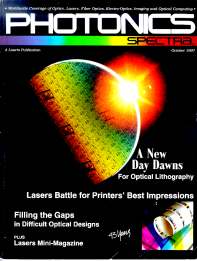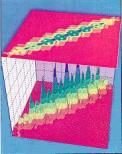











Press Releases
The following appeared in the July 24, 2000 Issue of the University of Rochester's Currents:
Light-harvesting molecule takes shape
For 20 years, researchers have experimented with artificially created, tree-like molecules that act like antennae and might someday play a key role in a number of processes, from releasing a drug inside the body to converting light to energy more efficiently than Mother Nature. Now researchers at the Unversity have computed what seems to be the most efficient configuration for one class of these molecules, and have published their results in the July 10 issue of Physical Review Letters."These are giant, light-harvesting molecules," explained Shaul Mukamel, professor of chemistry. "Each one is designed like a net that captures light and funnels its energy into its core, where we can make it do almost anything we want."
The fractal-shaped molecules, called "dendrimers," are currently used in laboratories to control chemical reactions, since researchers can use them to release a chemical at the perfect moment, but only recently have scientists realized some of their potential. The organic molecules look like snowflakes, with tiny limbs branching out in all directions to capture a ray of light and channel its energy into the molecule's heart. There the light energy can be harnessed to generate power like a super-efficient photoelectric cell or to release a chemotherapeutic drug inside a tumor after it's been carried through the bloodstream. Dendrimers might even one day act as the initial necessary step in photosynthesis, improving the light-harvesting task performed naturally within any green leaf, to yield crops that can grow where none grew before.
To determine the most efficient configuration, graduate student Subhadip Raychaudhuri and chemistry research associate Vladimir Chernyak worked with Mukamel and Yonathan Shapir, professor of physics, to run thousands of computer simulations. These simulations incorporated everything known about the way atoms interact in order to see whether there was a certain shape or size of dendrimer that caught and funneled light's energy best. "What surprised us is that there is a point of diminishing returns," said Shapir.
Many scientists have envisioned building bigger and bigger molecules, since a dendrimer needs as many light-catching limbs as possible to capture light, much as a big tree snares more light than a smaller one. But the researchers found a problem: the larger the molecule, the harder time it had funneling that light energy toward its center.
In research funded by the National Science Foundation, the team of chemists and theoretical physicists ran the simulations until they found the magic number for one particular family of dendrimers: nine. The dendrimers could branch out up to nine times before their ability to funnel light became compromised. The team expects the findings to set the guidelines for the synthesis of large fractal-like dendrimers that could be used in many chemical reactions, from making magnetic resonance imaging (MRI) scans more accurate, to converting sunlight to energy for weakened plants.
 The following appeared in: Photonics Spectra (November 2000, Pg. 32) - By Kevin Robinson
The following appeared in: Photonics Spectra (November 2000, Pg. 32) - By Kevin Robinson
Bigger Isn't Always Better for Molecular Light Funnels
ROCHESTER, N.Y. - Researchers at the Unversity of Rochester have determined the ideal size for a light-harvesting molecule that one day may improve the light gathering of everything from photoelectric cells to genetically engineered plants. Led by physics professor Ynothan Shapir and chemistry professor Shaul Mukamel, the team has learned that after a certain size, the molecule phenyacetylene begins to lose its efficiency at channeling light to its center.Over the past decade, scientists have experimented with artificial molecules that funnel light. Until recently, many thought that the larger the molecule, the more light it could collect. The researchers determined that this is not the case and have devised a method to determine the optimum size of such molecules.
To test how size affects efficiency, the researchers developed computer models to gauge how long it takes the energy of a photon to reach the core, where it causes a desired chemical reaction. "These calculations dealt with two particular aspects of the dendrimers: the nonlinear potential and the inherent randomness due to their interactions with the solvent," Mukamel said.
Useful for thermal sensors
Because dendrimers-molecules that display a fractal branching structure-have branches of different lengths, the excitation energy moves in a nonlinear fashion toward the center. In addition, excitations take random paths to the center and can get lost on the structure in the process.The researchers first studied the effects separat5ely; then they combined them. "To include both the nonlinearity and the randomness, we had to run repeated computer simulations to mimic the many different ways the randomness can take," Shapir said. The found that if the molecule is too large, either effect increases the time for the excitations to reach the center. "Luckily, the optimal sizes associated with these two different effects were found to be identical," he said, so optimizing phenylacetylene's size for one factor will not adversely affect its performance by the other.
The researchers classified the molecule by the number of times it branched, which is known as its generation. According to Mukamel, their calculations show that for phenylacetylene the optimal size is nine generations.
Because the work is in its early stages, Mukamel, said, any applications are only possibilities. The model ahs potential in a variety of fields, tailoring dendrimers for use as drug delivery systems in medicine, as thermal sensors and in photovoltaics.
The research team published its findings in the July 10 issue of Physical Review Letters.

|
Scientists Construct Model to Illustrate Behavior of Optically Excited MaterialsThe following appeared in: Photonics Spectra (October 1997, Pg. 50) |
 A group of researchers based at the University of Rochester and led by Shaul Mukamel has developed a set of theoretical models that illustrate how properties of both small and large molecules change when optically excited. Up until this point, scientists could conduct calculatiosn on the properties of single molecules but lacked a method to explain the behavior of large molecular structures. Mukamel said the new methods would enable scientists to better manipulate the structure of optical materials.
A group of researchers based at the University of Rochester and led by Shaul Mukamel has developed a set of theoretical models that illustrate how properties of both small and large molecules change when optically excited. Up until this point, scientists could conduct calculatiosn on the properties of single molecules but lacked a method to explain the behavior of large molecular structures. Mukamel said the new methods would enable scientists to better manipulate the structure of optical materials.
Web design by Ronen Mukamel.
